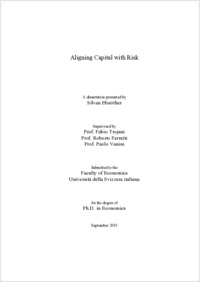Aligning capital with risk
- Ebnöther, Silvan
- Trojani, Fabio (Degree supervisor)
-
10.09.2015
Thèse de doctorat: Università della Svizzera italiana, 2015
Economic capital
Risk capital
Value-at-risk
VaR
Market risk
Capital charge
Cost of capital
Risk budget
Exposure management
Corporate governance
Risk management
Operational risk
Extreme value theory
Credit risk management
Portfolio management
Risk measurement
Coherence
Expected shortfall
Factor model
Optimal limit policy
Partial information
Adverse selection
English
The interaction of capital and risk is of primary interest in the corporate governance of banks as it links operational profitability and strategic risk management. Senior executives understand that their organization's monitoring system strongly affects the behaviour of managers and employees. Typical instruments used by senior executives to focus on strategy are balanced scorecards with objectives for performance and risk management, including an according payroll process. A top-down capital-at-risk concept gives the executive board the desired control of the operative behaviour of all risk takers. It guarantees uniform compensations for business risks taken in any division or business area. The standard theory of cost-of-capital assumes standardized assets. Return distributions are equally normalized to a one-year risk horizon. It must be noted that risk measurement and management for any individual risk factor has a bottom-up design. The typical risk horizon for trading positions is 10 days, 1 month for treasury positions, 1 year for operational risks and even longer for credit risks. My contribution to the discussion is as follows: in the classical theory, one determines capital requirements and risk measurement using a top-down approach, without specifying market and regulation standards. In my thesis I show how to close the gap between bottom-up risk modelling and top-down capital alignment. I dedicate a separate paper to each risk factor and its application in risk capital management.
- Language
-
- English
- Classification
- Economics
- License
-
License undefined
- Identifiers
-
- RERO DOC 257419
- URN urn:nbn:ch:rero-006-114587
- ARK ark:/12658/srd1318417
- Persistent URL
- https://n2t.net/ark:/12658/srd1318417
Statistics
Document views: 283
File downloads:
- Texte intégral: 193
